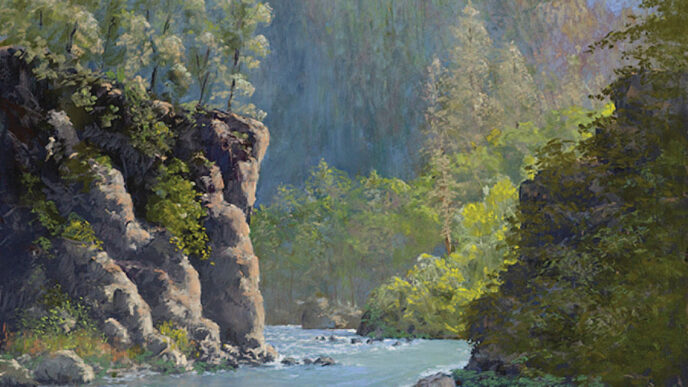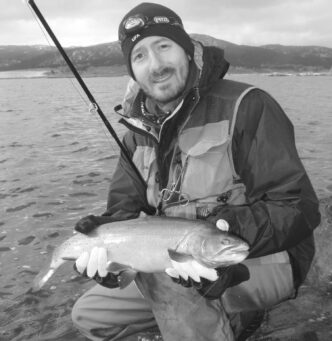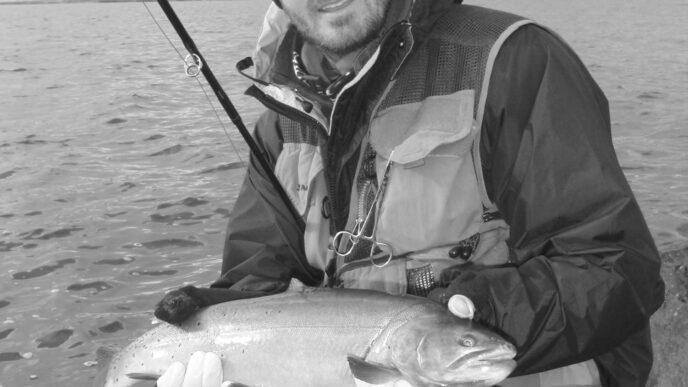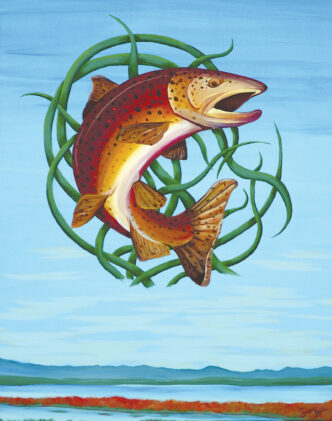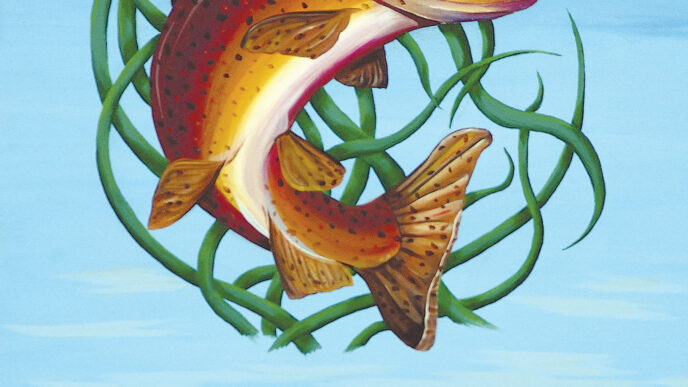Small roach are found everywhere in Britain and are usually fairly easy to catch, but big roach are wily and therefore held in very high regard. Size, of course, is relative. A roach of a pound and a half is a big one. . . .No other species is as subtle and enigmatic, no other species makes as great demands on the angler’s patience and watercraft. . . .To catch a prime specimen, though, and to linger for a moment on its exquisite fashioning — on the amber eye, the white gold of the gill covers, the vermillion fins, the iridescent violet scales — is to forget the hours of frustration. They are most beautiful of freshwater fish and possessed of a strength that belies their Marie-Antoinette-like delicacy.
—From Blood Knots, A Memoir of Fathers, Friendship, and Fishing, by Luke Jennings, a passage describing the roach, a cyprinid, third cousin to a carp, which to an American eye looks like a silvery, slightly oversized golden shiner.
Those who began fishing as small fry enjoy glorious memories created by fish we’d consider small fry today. We often caught these in places we no longer bother to visit, even if they still existed, using tackle we might describe, fondly or not, as pretty crummy then and barely quaint now. One of my favorites of these adventures was a sneak attack, launched after another nasty sixth grade day, on the pond of a golf course whose third fairway bordered Madison #2’s high-jump pit. A bluegill. I hooked him on a hand line using a bread ball pinched off the uneaten half of a federally subsidized American cheese sandwich. He was seven inches long.
Seven inches oh my gosh has there ever been a bluegill this big in the world?
Oh, but some of us were easy to please. And more’s the pity, I think, if we can’t return to that condition.
I mean that sincerely. It’s no secret that our measures of success depend upon expectations. Meet yours, all’s well. Exceed them, you’re elated. Set your sights too high, however, and disappointment is inevitable. And remembering that is ever more important as sport angling conditions change almost everywhere. In a few places — very few, worldwide — they’ve improved and may continue to do so, shepherded by aggressive constituents. Elsewhere, as in millions of other venues, the present’s more ashen than rosy by comparison with recent history, but we know that our ashen will look rosy in the future.
It’s easy to be bitter about that, and many of us are. But let us face this: That’s a choice of sorts. If we’re unable to return to an angler’s blissful ignorance, we can still adapt and probably must, if we’re to be happy again.
To that end, a recent column discussed this publication’s long habit of identifying unique opportunities, especially when it’s come to species that might be game. We’ve pushed, it’s true. But we’re not the only one, and we’re tempted to look back to England for guidance and inspiration. Not to the heritage of fly fishing we’ve long revered, but to another tradition, more popular there, but almost unknown in this country — to a dark angling art that is not quite bastard, but is, worse yet my dear fellows and fellowettes, terribly, terribly common.
Not Quite Everything Important to Us About Coarse Angling
Great Britain: from no other nation, or, now, no other collection of sovereign and semi-sovereign states, has our own taken so much — language, culture, laws. Noble concepts of honor, duty, and romantic love. Also a class consciousness that we publicly condemn and privately embrace by substituting net worth for birth and breeding. England’s influence on us is beyond measure, certainly, but it has diminished over time. Common courtesy remains just that Over There, for example, and the phone hacking of private citizens by Rupert Murdoch’s empire has been a big-issue news story for almost a year, even as the same crime committed here against the families of 9/11 victims goes all but unnoticed on this side of the Atlantic. In a few areas of American life, such degradation of influence is retarded, and fly fishing’s a fine example. But let’s be honest: While we may admire Walton and the Dame, many of our traditions are of far later origin, tracing back to pleasures and practices primarily reserved for the aristocracy or for the landed gentry at least. It was royal Atlantic salmon flies we admired and used, and so were the rods we imported, designs we employed as models until we improved them. Far more importantly, we continue to adhere to royal traditions, including attitudes about noble fish and the behavior expected from proper anglers. If pressed, one could argue that our appreciation of these sustained the sport in the form we enjoy it today. I think that’s likely true, and if some of the Old World protocols fade, it’s not my intent to hurry the process. Instead, I would like to introduce another English fishing tradition beloved by a tribe of Everyman anglers, proudly egalitarian and in its own way as complex and sophisticated as the tradition that the British created for flies.
Coarse Angling: I’d never heard the phrase prior to a late 1980s visit to my brother in London. Naturally, he quickly guided me to the Hardy’s store, along with other premier outlets, where I found nothing surprising, except for the number of American brands there. But some days later we were riding a slow train that had just emerged above ground from the Tube when I spotted an impressive display of rods standing upright outside the doorway of a shop at the end of low row of worn stores. Any show of fishing tackle arrests my eye, of course, but what made them bulge was that these looked to average 11 to 14 feet long, with many longer, several approaching 25, and one I could swear stood 30 feet tall.
My brother answered my bleat and point with a smile. “Not fly fishing,” he said firmly. “That’s a coarse angling store, for coarse fisherman.”
Coarse?
He thought it referred to the kinds of fish pursued, also the way they fished for them, but acknowledged that the English are a subtle folk, so he couldn’t really be sure. “It’s what the commoners do,” he advised me, meaning a couple million people who hadn’t the bloodlines or money — it often takes both — to own or access trout and salmon waters. He was pretty sure it was mostly about bait, but if I still wanted to investigate, he would be happy to drop me off there on his way to work the next morning.
I did. And much as I’d like to launch a detailed description here — I have, elsewhere, over the years — in the end, it’s tangentially related to my theme, enough to merit only two paragraphs or three.
“Coarse” does apply to species of fish — lots, as in anything not a salmon, trout, or char. “Coarse” also applies to tackle and techniques. Lures are used for several beasts familiar to us: their pike, which appear to be northern; a perch that’s a doppelganger for our Eastern yellow-barred variety; and zander, kin, I believe, to walleyes. (Not too much to learn here, from what I can tell.) But bait and bait fishing is the meat and potatoes of this pursuit, as suggested by one of my books on the subject. In The Fisherman’s Guide to Coarse Fishing, discussion of plugs, spinners, and lures consumes all of 12 pages, while baits and baitfishing fill 130.
Meat and potatoes, it happens, are among the scores of enticements offered on hooks, along with maggots, worms, caterpillars, wasp larvae, silkweed, and boiled flour balls for carp — “boilies,” saturated with hundreds of flavors, from anise to garlic and on to watermelon, along with secret custom blends with tempting names such as Tropical Delight. These may be merely curiosities, but I found coarse fishing’s techniques and tackle rigging amazing, employed in “float fishing,” “ledgering,” “pole fishing” (that 30-footer — and they range up to 16 meters), and “trotting.” Comparing these with a Power Bait setup is like equating a World Series game to “fetch.” The care spent on designing and refining terminal tackle is truly impressive: a “basic rig for Trent,” for example, involves a handmade quill float with a “dust shot” pinched a few feet down the leader, then a second shot located several feet below, followed beneath by a gang of four — space — then a trio — space — then a pair — space — and finally a single — space — placed above a “hook just above the river bed.” And lest you imagine that’s the most complex rig around, consider that others use combinations of split shot that come in 11 sizes and that splits are only one of 24 shapes of sinkers, “leads” with names such as “Barleycorn,” “Coffin,” “Capta,” “Half Moon,” and “Arlesey Bomb.”
There’s a little to learn there. (I have tried spaced splits, as have others.) But along with reliance on bait — this, I theorize, due in part to the fact many coarse fish species are omnivores — there’s another reason why British and American fly fishers have disdained to consider seriously the commoners’ game. Coarse anglers’ commitment to chumming, what they call “feeding the swim,” is so fanatic that those I’ve talked to can’t imagine fishing without it. What’s illegal almost everywhere in U.S. fresh waters, and also considered unfair, is an art form for them, employing sling shots, devices that drop chum from trees, dissolving “plastic” goodie bags, and sinkers attached to perforated tubes that leak out live attractions such as maggots and mealworms.
Which might lead one to ask . . . “Lesson? What lesson?”
Odes and Admiration
For much of Britain’s history, ordinary anglers’ chances to catch noble fish were proscribed by law: de jure, at times, subject to severe punishments, then de facto, as salmon and trout waters became exclusive. They could fish for leftovers — undesirables — to put food on the table, but by the nineteenth century, that wasn’t the only reason they wet lines. The roach praised in the epigraph, for example, is almost inedible, and so are the rudd, among others, including the chub, described in this passage of John Aston’s book A Dream of Jewelled Fishes. Aston, though, doesn’t hesitate to praise the lowly, here describing the River Swale, where
…there are times when you want to be on the river, but trout are the last thing you want to fish for. Hot dogday afternoons in July or August; brassy sun, no cloud cover and low and clear water So you stalk the banks, polaroided and baseball capped. And you see lots of chub. They are spooky — Walton didn’t term them the fearfullest fish for nothing — but they are curious, bustling, busy. They sail in great shoals in and out of the willow branches, and in the gravel shallows will sunbathe and sport for hours. They chase the odd minnow, they turn over a few stones to see what lies underneath. But what they are really doing is hanging out, fooling around with their mates in the sun. There is an element of blokeishness, of peer group antics, of competition and boisterousness. If any fish were to utter the words “Who spilled my pint?” you just know it would be some brassy four pound chub, swaggering like a trailer-trash England supporter, St. George’s flag on a Tshirt and with attitude to spare.
By my lights, that prose approaches tribute — this from an author who “loves best fly fishing for trout on streams.” Now here’s another, from Magic in the Water, by Alan Tomkins, praising that perch that looks like ours. “It stands alone, doesn’t it? The perch — bold, bristling and arrogant. Once seen, who can forget those striking Bernard Venables paintings of perch chasing minnows? If those pictures don’t provoke a response then nothing will . . . not as an angler, anyway They command respect, even the tiny ones, for their sheer nerve. When you hold them in your hand they almost make you feel inferior.”
In other words . . .
People deprived of what were presumed “the best” of opportunities did more than adapt. They look leftovers and made feasts.
Us, Too
So have we, already — adapted. Until the last quarter of the twentieth century, fly fishing for the sunfishes and basses had fallen so far out of favor that dedicated fly-fishing magazines would rarely, if ever, run articles about them. No longer. As with a host of other freshwater, surf, and sea species — some unknown to the mainstream, others so disdained you’d expect they had scarlet letters tattooed on their dorsal fins — these are now pursued by a rapidly growing numbers of enthusiasts, a few of whom have even “switched over.”
Many of us have not, however. And for the most part, that includes me. We continue to favor trout, steelhead, and salmon, and in California, stripers, and will persevere in efforts to protect them. But choosing a “favorite fish” need not reduce other species to the second tier — “coarse,” by definition.
That brings us round to those standards we set for satisfaction and success. Because what’s evident in the tackle, techniques, rigging and writings of England’s Other Angling History is what looks like a key element to expectation — in a word, appreciation.
And when it comes to appreciation, at least one author and guide may have either risen to Enlightenment, or gone beyond the Pale, God bless him. And so I must end with a tidbit from Sam Davis, who guides fly fishers in the French province of Bretagne, from the Web site www.fishandfunbrittany.com:
The future is ‘bleak’ indeed, well ‘bleak fly fishing’ that is. What do you do to sharpen your river trout fly fishing skills when the season is over? Or better, what do you do with a river full of fish which are game to take the fly? . . . As a guide constantly searching for new fly fishing opportunities, you just have to give this species a shot. Be ready to fire lots of casts with flies normally tied under the guidance of an electron microscope, loads of takes which range from little kisses to acrobatic fish flipping lunges, and on occasion, hooking up with Mr. no-reputationas-a-fly-fisher’s-fish, and having lots of giggles while stripping the line in.
For the record: The bleak, another cyprinid, is, well, smallish, with the national record weighing in at just over four ounces.







